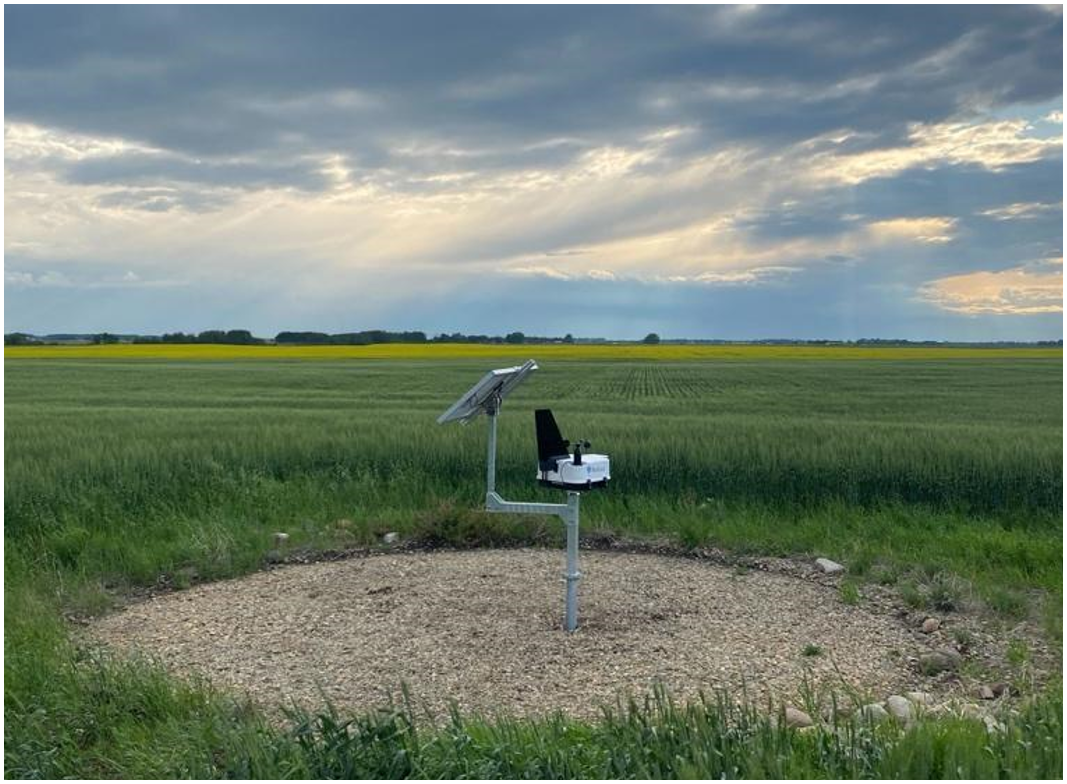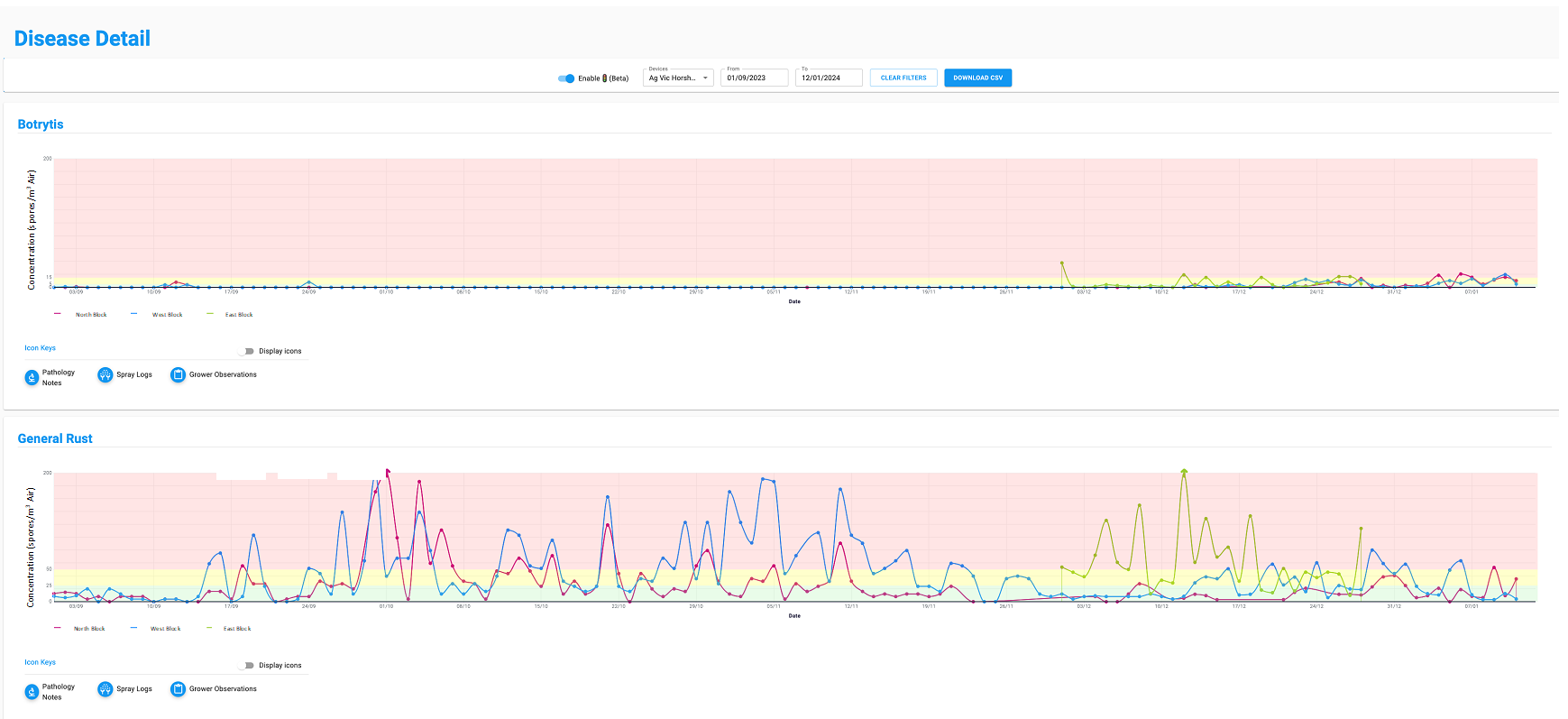The regional disease surveillance network: a BioScout endeavour
The regional disease surveillance network: a BioScout endeavour
Author: Michelle N. K. Demers (BioScout Pty Ltd), Edward Gubbins (BioScout Pty Ltd), Lewis Collins (BioScout Pty Ltd) | Date: 15 Feb 2024
Take home message
- BioScout technology empowers proactive disease management by combining automated microscopy with machine learning to provide growers with near real-time airborne fungal data.
- Launching in 2024, Australia's first regional airborne disease surveillance network, in collaboration with the GRDC, will deploy BioScout units across three regions, offering valuable data on key threats until early 2026.
- Free access for GRDC-approved users until the end of 2025 provides an opportunity to leverage this novel resource and optimise disease management strategies.
- Register your interest to stay informed about network availability and contribute to shaping a future of informed and sustainable crop protection.
The disease problem
Australia's grain crops face substantial yearly losses due to diseases. The FAO (2019) estimates that plant diseases are responsible for 20 – 40% of crop losses on average, costing the global economy US$220 billion annually. In Australia, Murray and Brennan estimated back in 2009 that foliar fungal infections cost the grains industry over AUD 470 million annually despite spending around AUD 84.3 million on fungicides; these numbers are now likely much higher. Addressing these losses can boost crop production profitability by protecting yield while promoting sustainable practices without additional land clearing or inputs.
A key issue with disease management is knowing which diseases are present in a given area before plants are symptomatic. Spores of disease-causing fungi are largely invisible; since plants are asymptomatic during early infection stages, growers must make fungicide application decisions on weather conditions and plant growth stages or wait until after plants show symptoms, which is generally too late to prevent yield and economic losses from disease damage to the crop. These decisions are often made without knowing for certain whether plants are at risk of infection.
BioScout technology
BioScout's advanced automated SporeScout system (Figure 1) aims to address these issues by monitoring airborne disease-causing fungi in near real-time, providing data-based insights for sustainable and profitable production. SporeScout units photograph microscopic airborne particulates, analyse that imagery to identify and quantify fungal spores of interest, and scales this process through machine learning. Data from the SporeScout units is displayed on BioScout’s online dashboard, with graphs containing the airborne spore concentrations of several pathogens of interest, which are updated daily (Figure 2).
Automated disease surveillance is currently available for the following broadacre pathogens:
- General rust (Puccinia spp.)
- Blackleg (Leptosphaeria maculans)
- General Alternaria (Alternaria spp.)
- Powdery mildew (Blumeria graminis)
- Botrytis (Botrytis cinerea)
Figure 1. A SporeScout unit in wheat. The unit is powered by a solar panel on the left side, and a black wind vane keeps the intake nozzle consistently pointed into the wind for optimal air sampling.
Figure 2. A graph from the BioScout dashboard displaying airborne concentrations of general rust detected through the SporeScouts during an outbreak. Two SporeScouts were placed at a site in Victoria from June to November 2023. North Block (pink line) and West Block (blue line) were located 776 m and 600 m away from a wheat rust nursery, respectively. The black arrow indicates the day that symptoms (flecking) were first observed at the nursery, and the red arrow highlights the approximate day that plants had peak infection and were ready for resistance scoring. The traffic light system in the background provides an approximate indication of the quantity of spores in the air, with green (< 25 spores/m3 air) indicating low levels, yellow (25 - 50 spores/m3 air) indicating moderate levels and red ( > 50 spores/m3 air) indicating high levels. Arrows at the top of the graph indicate spore concentrations have exceeded 200 spores/m3 air, and the exact number can be obtained by hovering over the data point.
The data generated from this system can offer significant advantages to the agriculture industry and stakeholders. Early pathogen detection can enable more informed management decisions and swift, timely responses by farmers, preventing rapid disease spread and minimising economic losses. Growers can also see the impacts of any management decisions through responses in airborne spore loads. Moreover, SporeScouts also contain weather stations, offering localised weather data including temperature, humidity, pressure, rainfall, windspeed, wind direction, and air quality. This integration enhances the value of the spore monitoring network by enabling data-driven decisions for fungicide applications based on weather conditions and spore presence, reducing unnecessary chemical use, reducing the risk of fungicide resistance developing, and improving sustainability.
The regional disease surveillance network project
The Australian agricultural landscape is poised for improvements in disease management with the launch of the nation's first dedicated airborne fungal pathogen surveillance network. This groundbreaking initiative, commencing in April 2024, will deploy 60 SporeScout units across all three GRDC regions. The network collaborates with researchers, state pathologists in each growing region, and the GRDC. This strategic deployment of SporeScout units, augmented by four iMapPESTS Sentinels for DNA validation, will provide near real-time data on the presence and concentration of airborne fungal spores across vast regions. This unprecedented access to granular, geographically specific data empowers growers and researchers alike. An example of the website for the surveillance network can be seen in Figure 3 and Figure 4.
The network's design also incorporates a robust research component. Several SporeScout units in the network will be placed within existing disease field research trials. The data generated from these trials will serve to provide recommendations regarding how best to incorporate BioScout data into existing integrated disease management practices, maximising the return on investment for growers and the industry as a whole.
Figure 3. Example landing page for the regional disease surveillance network. Upon entering the site, users will see a map with icons displaying the locations of SporeScout units in that region. Users can zoom in on the map and select individual units to view spore concentrations and weather data. Note: this is a mock-up and may vary from the real landing page.
Figure 4. Example of the landing page scrolled down. Users can select multiple SporeScout units and view the spore concentrations of the pathogens we track. Users can filter the data by selecting specific SporeScout units and date ranges and can download the filtered data in a CSV file. Note: this is a mock-up and may vary from the real landing page.
Participation in this initiative is available to GRDC-approved users free of charge until April 2026. We invite researchers, industry stakeholders, and growers to join us in shaping the future of Australian agriculture by contributing to this transformative project. If you would like to have access to the disease surveillance network, we encourage you to provide your email address using the QR link below.
Conclusions
- BioScout technology provides fully automated disease surveillance for airborne pathogens
- A regional airborne disease surveillance network will come online in early 2024, providing data on airborne pathogens as well as weather variables available to view online or download as a file
- Research involving BioScout units in disease management will be undertaken, with recommendations with how best to use BioScout data provided to growers later this year
References
FAO, 2019. New standards to curb the global spread of plant pests and diseases. Murray, G.M., Brennan, J.P., 2009. Estimating disease losses to the Australian wheat industry. Australas. Plant Pathol. 38, 558–570.
Acknowledgments
The research undertaken as part of this project (PROC-9176750 or BIS2305-001RTX) is made possible by the significant contributions of growers through both trial cooperation and the support of the GRDC. The author would like to thank them for their continued support. We would also like to express our gratitude to SARDI, DPIRD and NSW DPI for supporting this project.
Contact details
Michelle Demers
Head of Science, BioScout
Ph: 0424 611 345
Email: michelle@bioscout.com.au
URL: BioScout
Date published
February 2024
GRDC Project Code: BIS2305-001RTX,




